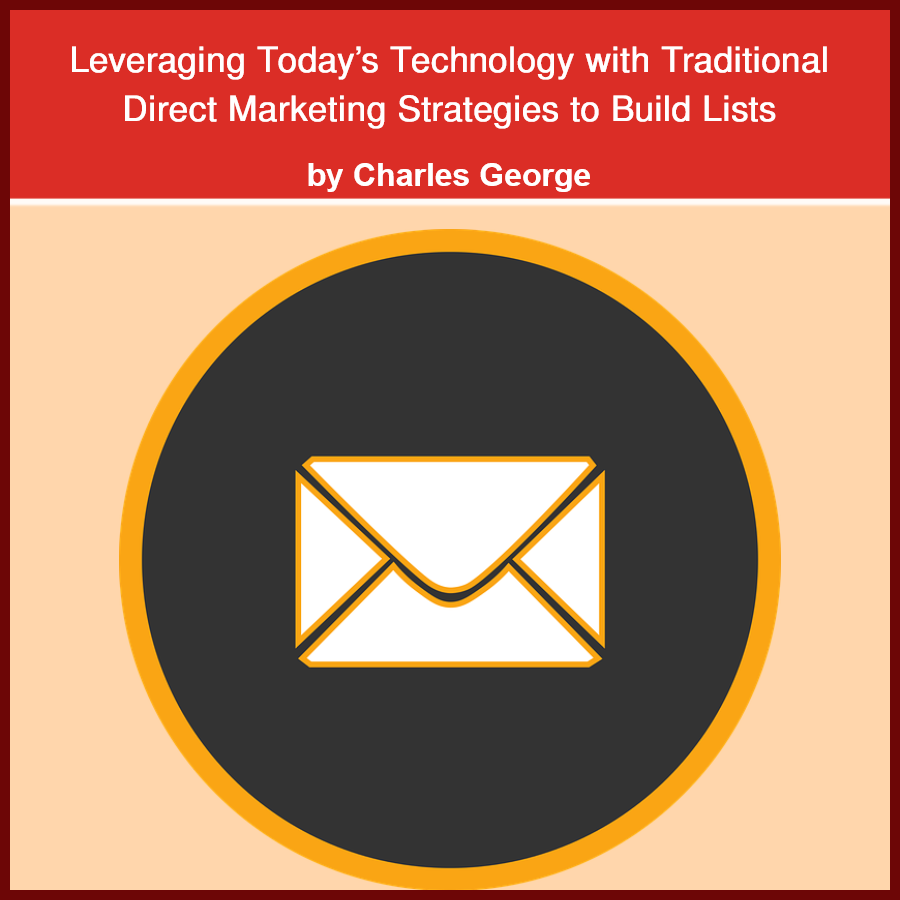by Charles George

Over the past couple of months, I have been intensely studying new ways to build a list.
With every list I have built over the last 20 years, I’ve never been loyal to any one method of building a list.
Instead, I analyze the resources and assets available, and then I leverage those assets and resources to build the list.
Over the years, I’ve used Google Ad Words and Facebook ads.
I’ve bought banner ads on targeted websites and dedicated emails in ezines.
I’ve leveraged websites and blogs.
I’ve leveraged social media posts and have collaborated with others to build the lists.
I’ve leveraged the lists and audiences of direct and indirect competitors.
I’ve used free methods, affiliate marketing, paid ads, media buys, and any other way I can think of to build a list.
Even before focusing on email lists, I worked with direct mail lists.
With direct mail, I almost always started with the customer database before doing customer acquisition. First, I created an offer and sent a direct mail package to their customers to generate revenue. This still works today with email, and I still deploy this strategy with my clients.
Studying the Old and the New for List Building
Over the last few months, I’ve read classic direct marketing books about selling subscription products, magazines, newsletters, books, and other recurring revenue or continuity products. Plus, I’ve studied the sales letters that led to many of the subscribers for the products.
My thirst to improve my direct marketing knowledge never seems to be quenched.
Most of the books focused on publishing products. That’s my primary interest these days…building thriving publishing businesses.
Also, I’ve been studying how younger generations use the web to rapidly build email lists. It’s fascinating some of the things they are doing.
The reason I am studying the legendary masters of direct mail is strategies and fundamentals don’t change. What motivated someone in the ’50s & ’60s to purchase still applies today. Strategies and fundamentals rarely change.
What does change are the tactics. Because of technology, the tactics are changing faster than ever before. This will continue, with the speed of change increasing more rapidly.
Part of my study is to keep up with the ever-changing technology and how it’s being leveraged.
I’m studying the legends of direct marketing to continue improving my skills around the fundamentals.
What can I learn from studying the legends of yesterday, along with today’s generations, to grow email lists faster?
What can I do to build a stronger and more solid business?
Applying the Old to the New for List Building
In the past, with the volume of direct mail pieces being sent, the marketer had to understand their essential direct marketing numbers. The more thoroughly they understood their numbers, the better.
In Dick Benson’s book Secrets of Direct Mail Success, he talks about one of his newsletters. For acquisition, he mailed 30 million direct mail pieces per year. His top competitors only mailed 5 million per year. He could do this because he understood the value of a customer more than his competitors. Also, he invested more time in understanding the lists.
He understood the value of his customers, and that drove the number of pieces mailed. In comparison, his competitor’s marketing budget was based on the previous year’s budget.
This allowed him to be far more aggressive with the acquisition. It also led to him having the newsletter with the most paid subscribers.
These principles can still be applied to building email lists today.
Email is the online version of direct mail.
What’s interesting about studying younger generations is that many are using free methods to build their list at first. This is fabulous to start, but for scalable acquisition, often there needs to be an investment in building the list.
Also, I haven’t read many of the new list builders discussing calculating the lifetime value of a customer. Many of them have talked about the cost per subscriber. This is an important metric, but understanding the value of a customer is an even better number to know. The value of a customer tells you how much you can invest in acquiring a new customer and still break even.
I believe many are not talking about customer value for acquisition because they primarily use free methods to build their lists. However, they are still building lists with more than 70,000 subscribers by combining both mostly free and some paid methods. Super impressive!
I find the times we live in fascinating!
Reaching critical mass with a new list is not always easy. It requires skills in understanding the ideal customer, developing offers, writing copy, engaging the list, and converting subscribers into customers. All direct marketing skills that I love.
I’ve also worked with large lists that weren’t profitable and turned them around and made them profitable.
How Am I Applying The Old and New Methods?
These days, I’m not really interested in leading the charge on many different lists.
Instead, I prefer coaching people through the process, creating more products to teach what I’ve learned, or building a community around these ideas, but not leading the teams of other businesses doing the work.
Today, I’m focusing only on a couple of lists. My goal is to implement more strategies in Dick Benson’s book. Plus, combine some of the new ways younger generations are building lists. All while continuing to develop and expand on my own methods to build growing, profitable lists.
Your list is your most powerful asset. If built correctly, it can transform a business and the list owner’s life.
I’ve watched this happen over and over again with the lists I’ve built.





Leave a Reply